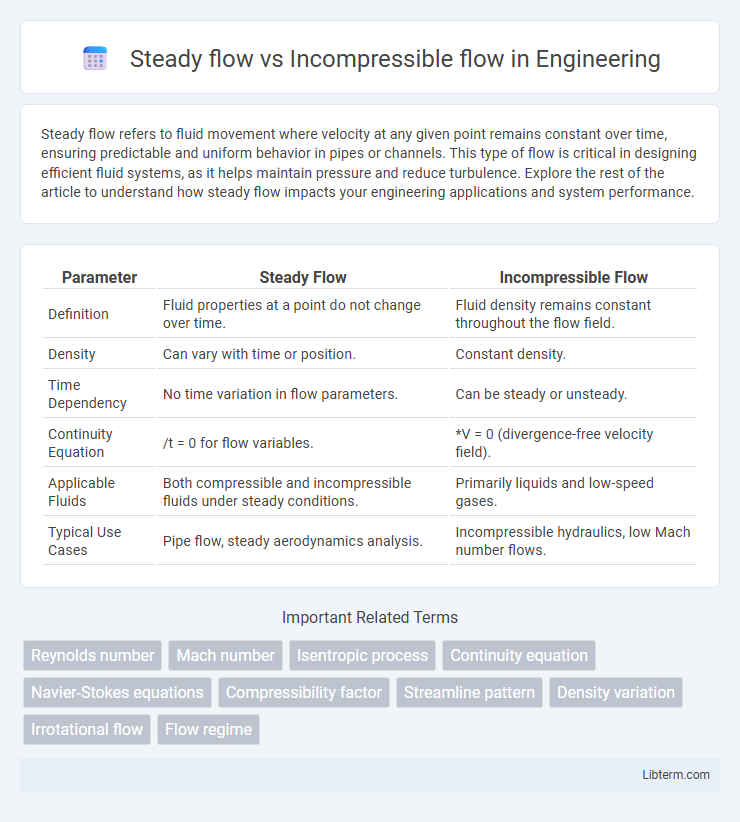Steady flow refers to fluid movement where velocity at any given point remains constant over time, ensuring predictable and uniform behavior in pipes or channels. This type of flow is critical in designing efficient fluid systems, as it helps maintain pressure and reduce turbulence. Explore the rest of the article to understand how steady flow impacts your engineering applications and system performance.
Table of Comparison
| Parameter | Steady Flow | Incompressible Flow |
|---|---|---|
| Definition | Fluid properties at a point do not change over time. | Fluid density remains constant throughout the flow field. |
| Density | Can vary with time or position. | Constant density. |
| Time Dependency | No time variation in flow parameters. | Can be steady or unsteady. |
| Continuity Equation | /t = 0 for flow variables. | *V = 0 (divergence-free velocity field). |
| Applicable Fluids | Both compressible and incompressible fluids under steady conditions. | Primarily liquids and low-speed gases. |
| Typical Use Cases | Pipe flow, steady aerodynamics analysis. | Incompressible hydraulics, low Mach number flows. |
Introduction to Fluid Flow Concepts
Steady flow describes fluid motion where velocity at any point remains constant over time, ensuring predictable patterns in fluid dynamics. Incompressible flow assumes constant fluid density, simplifying the continuity equation by eliminating density variations, a key concept for liquids and low-speed gas flows. Understanding the distinction between steady and incompressible flow is crucial for accurate analysis in fluid mechanics and engineering applications.
Defining Steady Flow
Steady flow is defined as a flow condition where the fluid properties such as velocity, pressure, and density at any given point do not change over time. In contrast, incompressible flow specifically refers to fluid flow with constant density, regardless of time variations. Understanding steady flow is crucial in fluid dynamics as it simplifies analysis by assuming time-independent flow characteristics.
Understanding Incompressible Flow
Incompressible flow refers to fluid motion where the fluid density remains constant throughout the flow field, simplifying the continuity equation to a divergence-free velocity field. This assumption is valid for liquids and gases moving at low Mach numbers, where density variations due to pressure or temperature changes are negligible. Understanding incompressible flow enables efficient analysis in engineering applications such as hydraulic systems, aerodynamics at subsonic speeds, and pipeline design.
Key Differences Between Steady and Incompressible Flow
Steady flow refers to a fluid motion where velocity at any given point remains constant over time, whereas incompressible flow assumes fluid density remains constant despite pressure variations. The key difference lies in flow characteristics: steady flow addresses the temporal invariance of velocity fields, while incompressible flow emphasizes density constancy, often simplifying continuity equations. Engineering applications leverage steady flow for time-independent analysis and incompressible flow for liquids or low-speed gases where density changes are negligible.
Physical Examples of Steady Flow
Steady flow occurs when fluid properties at a point do not change over time, exemplified by water flowing steadily through a pipe or air moving uniformly over an airplane wing. Incompressible flow, often observed in liquids like water and low-speed gases, assumes constant fluid density. Physical examples of steady flow help analyze hydraulic systems, cardiovascular blood flow, and wind tunnel testing where velocity and pressure remain consistent.
Real-World Instances of Incompressible Flow
Incompressible flow occurs when fluid density remains nearly constant, often seen in liquids like water flowing through pipes or rivers, where velocity and pressure changes do not alter density significantly. Real-world instances include hydraulic systems, ocean currents, and airflows at low Mach numbers, where volume conservation simplifies calculation without sacrificing accuracy. Understanding incompressible flow in steady conditions aids in designing efficient fluid transport and environmental modeling systems.
Mathematical Representation of Each Flow Type
Steady flow is mathematically characterized by a velocity field \(\mathbf{v}(x,y,z,t)\) where \(\frac{\partial \mathbf{v}}{\partial t} = 0\), indicating velocity components at every point remain constant over time. Incompressible flow satisfies the continuity equation \(\nabla \cdot \mathbf{v} = 0\), which ensures constant fluid density and divergence-free velocity field. These conditions combine in fluid dynamics models to analyze flow behavior, typically using the Navier-Stokes equations adapted for steady or incompressible criteria.
Impact on Continuity and Energy Equations
In steady flow, fluid properties at a point do not change over time, ensuring the continuity equation simplifies to a constant flow rate across any cross-section, while incompressible flow assumes constant density, allowing the continuity equation to reduce to the divergence of velocity being zero. For energy equations, steady flow eliminates time derivatives, enabling straightforward application of Bernoulli's equation, whereas incompressible flow maintains constant density, which simplifies the energy equation by removing density variation terms and affecting pressure-energy relationships. Understanding these distinctions is critical in fluid dynamics to accurately model mass conservation and energy transfer in various flow conditions.
Applications in Engineering and Industry
Steady flow, characterized by constant velocity at every point over time, is crucial in designing pipelines and HVAC systems to ensure predictable fluid movement and energy efficiency. Incompressible flow, where fluid density remains constant, is widely applied in hydraulic machinery and water distribution networks, optimizing pump and turbine performance. Both flow types are foundational in aerospace engineering for aerodynamic analyses and in chemical processing for mixing and reaction control.
Summary: Choosing the Right Flow Assumption
Steady flow assumes fluid properties at a point do not change with time, ideal for analyzing systems with constant operating conditions. Incompressible flow assumes constant fluid density, suitable for liquids or gases at low Mach numbers where density variation is negligible. Selecting between steady and incompressible flow depends on the problem's temporal and density variation characteristics for accurate fluid dynamics modeling.
Steady flow Infographic

 libterm.com
libterm.com